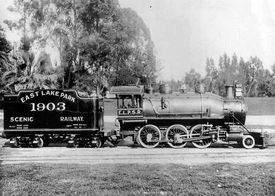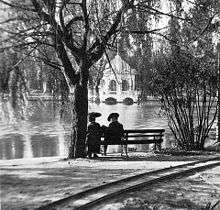Eastlake Park Scenic Railway
The Eastlake Park Scenic Railway was a 984 m (3,228 feet) long miniature railway in the 1:3 scale with a gauge of 18 in (457 mm), which operated from 19 May 1904 to 11 May 1905 in the Eastlake Park (now Lincoln Park) in Los Angeles in California.[1][2]
| Eastlake Park Scenic Railway | |
|---|---|
 Loco No 1903 of the Eastlake Park Scenic Railway | |
| Technical | |
| Line length | 984 m (3,228 feet) |
| Track gauge | 18 in (457 mm) |
| Maximum incline | 7 % |
Track

The nearly one kilometer (0.62 mi) long narrow gauge railroad lead from the lake to the hills in the Eastlake Park, which is now called Lincoln Park. It started at the Lakeside Station near the main entrance of the park. From there the track crossed one of the lake's arms on a steel and concrete trestle bridge into a pampas grass plantation. After a bend the track continued on the perimeter of the park and along the railway line of the Southern Pacific Railroad across a driveway bordered with large fan palms. It winded through a small forest of sub-tropical shrubs and reached then Hillside Station. Here was the locomotive shed and a double-track area, in which the locomotive could be driven to the other end of the train before the return journey commenced. Hillside Station had also a water tower and an oil tank, as well as some sidings and a ticket booth.
The railway had five switches. The rails had a flattened T-shaped Vignoles profile and a weight of 8 lb/yd (3.97 kg/m). Including the sidings the track had an overall length of 1,045 m (3,428 feet).[3] More than 1,700 sleepers were used. The tightest curve had a radius of 16.5 m (54 feet). The Hillside Station laid 5.4 m (17 feet 9 inches) above the Lakeside Station and the maximum grade was 7 % on a 9 m (29.53 feet) long section.[4]
History
.jpg)
John J. Coit built the track of miniature railway and designed and probably even manufactured the steam locomotive. He had worked as a master machinist at the Johnson Machine Works, before he built and operated the profitable but short-lived Long Beach and Asbury Park Railway.[5] Due to being physically handicapped for two years when he designed the locomotive he focussed on a very user friendly design. He was friend ‚Shorty‘ Chase was a person of short stature and worked smartly dressed wearing a formal suit and a bowler hat as a conductor on all of Coit's railways.[6]
Abbot Kinney, the developer of Venice of America, was highly impressed by the railway and contracted Coit to build the Venice Miniature Railway on an estate in Venice Beach near Los Angeles. Coit transported his locomotive temporarily to Venice because of the delayed delivery of a new locomotive[5] and because the permit top operate the railway line in Eastlake Park had been cancelled on 11 May 1905 due to political changes,[2] to use it there on the new railway, which was inaugurated with the opening of the park on 4 July 1905.[5]
Coit returned in 1908 to Eastlake Park after a legal dispute with Kinney, and operated his locomotive No 1903 and his three cars for approximately two years until around 1910. Later he transported his equipment to the Urbita Hot Springs Railway.[7][8]
Locomotive
.jpg)
The oilfired steam locomotive No 1903 with a total length of 5.80 m (19 feet) from tip of pilot to end of tank couple and a height of 1,295 mm (51 inches) from the top of rail to the top of stack was of the 2-6-0 type.[6] The locomotive had some technical innovations, such as a valve control without eccentrics, which was easy to adjust and to maintain. The locomotive had automatic couplings and a bespoke oit burner, for which Coit filed a patent.[5]
The locomotive had a weight of 3.628 kg (8 pounds) including the tender, and 2,328 kg (5,134 lbs) excluding the tender. The tender had a capacity of 780 L (210 US gallons; 170 imperial gallons) water and 322 L (85 US gallons; 71 imperial gallons) oil. The weight of the locomotive was spread over six driving wheels with a diameter of 463 mm (18.23 inches) and two smaller wheels of a pony truck with the diameter of 254 mm (10 inches) onto the rails. The Vanderbilt type boiler had a maximum pressure of 10 bar (150 psi; 1,000 kPa) and delivered 25 horsepower (19 kW). The cylinders were 5 by 7 inches (127.0 mm × 177.8 mm) bore x stroke . The locomotive had a pulling power of 4.8 kN (1,100 lbf).[9][10][11][12][13]
Carriages
The passenger cars were suspended with helical coil springs on conventional bogies. They each had ten seats and were 4.26 m (14.0 feet) long and 0.96 m (3.1 feet) wide. They had a weight of 680 kg (1,500 lb) each and had Coit's automatic couplings at both ends.[4]
See also
- Billy Jones Wildcat Railroad
- Long Beach and Asbury Park Railway
- Seaside Park Railway
- Venice Miniature Railway
- Urbita Lake Railway
References
- Dwarf Railroad to be Opened - Lilliputanian Locomotive in Eastlake Park. Los Angeles Herald, Wednesday 18 May 1904.
- Tiny road must cease operating - Mayor training for fight with railways commences on toy line. Los Angeles Herald, 12 May 1905
- Arthur W. Line: Model Railways - XIX. - Eastlake Park Scenic Railway, Los Angeles, California. The Model Engineer and Electrician, 23 April 1908. S. 395.
- Arthur W. Line: Model Railways - XIX. - Eastlake Park Scenic Railway, Los Angeles, California. The Model Engineer and Electrician, 23 April 1908. S. 396.
- Peter Panacy: Venice Miniature Railway. A Brief History and Its Influence on the Billy Jones Wildcat Railroad.
- "Eastlake Park Scenic Railway (Lincoln Park), Los Angeles, California, 1904". Archived from the original on 2015-01-17. Retrieved 2016-07-08.
- Ken Middlebrook: About East Lake Park steam locomotive 1903 (Long description).
- Ken Middlebrook: East Lake Park steam locomotive 1903 (Some history).
- Arthur W. Line: Model Railways - XIX. - Eastlake Park Scenic Railway, Los Angeles, California. The Model Engineer and Electrician, 23 April 1908. S. 397.
- Arthur W. Line: Model Railways - XIX. - Eastlake Park Scenic Railway, Los Angeles, California. The Model Engineer and Electrician, 23 April 1908. S. 398.
- Arthur W. Line: Model Railways - XIX. - Eastlake Park Scenic Railway, Los Angeles, California. The Model Engineer and Electrician, 23 April 1908. S. 399.
- F. C. McCarn (or more likely F. C. McCain): A Miniature Scenic Railway. Locomotive Fireman's Magazine. October, 1904.
- F. C. McCain: A Novel Valve Motion. Locomotive Fireman's Magazine. November, 1904.